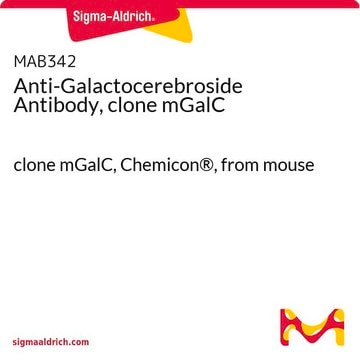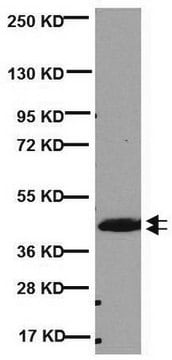MAB326
Anti-CNPase Antibody, clone 11-5B
clone 11-5B, Chemicon®, from mouse
Sinônimo(s):
2′3′-Cyclic Nucleotide 3′-Phosphohydrolase
About This Item
Produtos recomendados
fonte biológica
mouse
Nível de qualidade
forma do anticorpo
purified immunoglobulin
tipo de produto de anticorpo
primary antibodies
clone
11-5B, monoclonal
reatividade de espécies
canine, sheep, mouse, pig, bovine, rat, rabbit, human
não deve reagir com
guinea pig, chicken
fabricante/nome comercial
Chemicon®
técnica(s)
immunocytochemistry: suitable
immunohistochemistry (formalin-fixed, paraffin-embedded sections): suitable
western blot: suitable
Isotipo
IgG1
nº de adesão NCBI
nº de adesão UniProt
Condições de expedição
wet ice
modificação pós-traducional do alvo
unmodified
Informações sobre genes
human ... CNP(1267)
Descrição geral
Immunohistochemical localization of CNPase has shown the enzyme to be restricted to oligodendrocytes and Schwann cells. The enzyme appears to be distributed in single and double loose wraps of myelin and not in compact myelin as earlier thought by most investigators. CNPase is located on the inner and outer loops of myelin, paranodally and near the inner surface of the oligodendrocyte membrane. In plaque regions of multiple sclerosis patients, the enzyme is reduced, and when CNS myelin is decreased, CNPase is one of the earlier proteins to be lost from the myelin. In addition, an enzyme that is probably identical to brain CNPase is located in the outer rod segments within the visual system, and this protein is also recognized by the monoclonal antibody 11-5B. In mixed human gliomas, the enzyme levels are reduced, although about 5% of the oligodendrocytes occasionally show normal positive staining.
Especificidade
Imunogênio
Aplicação
A previous lot was used on primary oligodendrocyte cultures.
Immunohistochemistry:
A previous lot was used on rat hippocampus tissue and rat spinal cord.
Immunoblotting of myelin, the Wolfgram protein fraction, the SN4 fraction, tissue sections and mixed glial tumors (oligodendrogliomas, etc.) CNPase I (46 kDa) and CNPase II (48 kDa), which are differentially regulated during development, with the larger protein being expressed earlier than CNPase I during development.
Immunohistochemistry on both fresh frozen and paraffin embedded tissue (microwave pretreatment, ctirate pH 6.0).
Immunoblot:
Immunoblotting of myelin, the Wolfgram protein fraction, the SN4 fraction, tissue sections
and mixed glial tumors (oligodendrogliomas, etc.)
Optimal working dilutions must be determined by end user.
Neuroscience
Neuronal & Glial Markers
Qualidade
Western Blot Analysis:
1:1000 dilution of this lot detected CNPASE on 10 μg of Mouse Brain lysates.
Descrição-alvo
forma física
Armazenamento e estabilidade
Nota de análise
Western Blot: Fresh bovine whole brain extract, mouse brain lysate.
Immunohistochemistry: Rat hippocampus tissue, rat spinal cord tissue.
Outras notas
Informações legais
Exoneração de responsabilidade
Não está encontrando o produto certo?
Experimente o nosso Ferramenta de seleção de produtos.
recomendado
Código de classe de armazenamento
10 - Combustible liquids
Classe de risco de água (WGK)
WGK 2
Certificados de análise (COA)
Busque Certificados de análise (COA) digitando o Número do Lote do produto. Os números de lote e remessa podem ser encontrados no rótulo de um produto após a palavra “Lot” ou “Batch”.
Já possui este produto?
Encontre a documentação dos produtos que você adquiriu recentemente na biblioteca de documentos.
Active Filters
Nossa equipe de cientistas tem experiência em todas as áreas de pesquisa, incluindo Life Sciences, ciência de materiais, síntese química, cromatografia, química analítica e muitas outras.
Entre em contato com a assistência técnica








